As a bona-fide classical music nerd, I spend a majority of my time around music in some sort of way. But outside of the opening chords of the piano arrangement of “Danse Russe” from Petrushka and the iconic bassoon solo introducing “The Rite of Spring,” I’ll admit that I am completely unfamiliar with Igor Stravinsky’s works. But I’ve been hearing whispers of how epic and maestoso this 35-minute sacrifice of a virgin girl is. So when I saw those simple, yet beautiful, four words on the Nashville Symphony Orchestra website, I wanted to find out what the hype behind this orchestral fever dream was all about. Following a 30-minute bus ride to the Schermerhorn Symphony Center, I took my seat towards the front of the auditorium. After a contemporary orchestral piece and an interesting concerto performance, the intermission came and went. Spring was coming, and shit was about to go down.
Hearing that all-too-familiar bassoon solo live instantly gave me goosebumps, perfectly representing the ethereal and forlorn purgatory between winter and spring. Then, as if emulating springtime’s sudden burst of life and color, avant-garde tones and melodies emerge out of nowhere. Various textures flying everywhere, from chaotic runs from the woodwinds, to hammered-out bass tones from the low brass and string basses. At times, it felt like Stravinsky was tossing around pure gibberish in his score. There seemed to be as much intentionality in the thirty-second-long barrage of 16th-note triplets as the sounds of my music technology professor rubbing his butt against a MIDI keyboard.
And those solos: oh man. I’ve never heard a more cohesive trumpet section in my entire life. Cranking out scream-level notes over the organized mess of an orchestra truly shocked me. When the peacefulness of spring returned through the clarinet duet, the impressionistic melodies finally let me catch my breath. Then BOOM. The brass section nearly shattered the sound barrier, while chaotic strings demonstrated to me in real time how rock music originated in the offbeat accentuations of classical music. Then maestro Giancarlo Guerrero grabbed onto the handrail attached to the backside of his conductor’s podium and did 180s across the mass of musicians in front of him like he was jamming out to “Dance Dance Revolution” on max difficulty. Watching him conduct was like watching one of those inflatable tube people in front of gas stations on crack. I’m now persuaded to sign up for conducting courses in upcoming semesters.
Did you know that goosebumps could be sustained for an entire 35 minutes? I do now, as my face felt fuzzy as my blood flow normalized after the cosmic finale of this monumental performance. The audience around me jumped to their feet in applause, and our cheers could be heard over the busy Broadway bustle. And when Mr. Guerrero stood individual sections up for applause, he saved the viola section for last (because obviously, the best are saved for last).
Stravinsky’s “The Rite of Spring” is undoubtedly one of the pillars of recent symphonic revelation. Whether or not you understand or enjoy classical music, give it a listen. Yes, it’s atonal. Yes, it’s hard to dissect theoretically, even as a person trained in the classical arts. But it is a damn good concert piece that you should absolutely take the opportunity to witness IN-PERSON. “The Rite of Spring” is a wondrous balance of loud and soft, clarity and bewilderment, a titan of the 20th century, and the one piece of classical music that will never put you to sleep.
Featured graphic by Emma Chang

